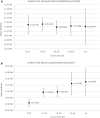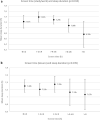Screen time and sleep among medical students in Germany
- PMID: 37726327
- PMCID: PMC10509232
- DOI: 10.1038/s41598-023-42039-8
Screen time and sleep among medical students in Germany
Abstract
Medical students are a vulnerable group for harmful health behaviours due to academic stress. Increased screen time is associated with adverse health behaviour, particularly delayed bedtime, shorter sleep duration and poorer sleep quality. This possible relationship has not yet been examined among medical students in Europe. Medical students at the Technical University of Dresden were invited to participate in an online questionnaire based cross-sectional study. To analyse correlations between screen time and sleep parameters, correlation coefficients, linear regression and mixed-model analysis were calculated. 415 students (average age 24 years, 70% female) were included in the analysis. The students reported an average of 7 h screen time per day and 7.25 h sleep duration per night. Approximately 23% (n = 97) reported sleeping less than 7 h per night and 25% (n = 105) reported fairly to very poor sleep quality. Students who reported more screen time for leisure went to bed significantly later (r = 0.213, p < 0.001). Students who spent more screen time for study/work tended to sleep shorter (r = - 0.108, p < 0.015). There was no significant association between screen time and sleep quality (p = 0.103). The results show a need for educational interventions to promote healthy sleep behaviour and to limit screen time.
© 2023. Springer Nature Limited.
Conflict of interest statement
The authors declare no competing interests.
Figures



References
-
- Balogh E, et al. Smoking habits of German medical students in Germany and Hungary. Pravention Und Gesundheitsforderung. 2017;12:255–260. doi: 10.1007/s11553-017-0605-2. - DOI
Publication types
MeSH terms
LinkOut - more resources
Full Text Sources

